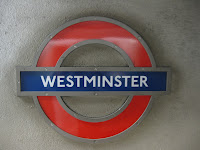 |
| Exterior shot Randy took |
Westminster Abbey is immense. The ceiling is over 400 ft high with many chambers and chapels and hallways. It is easy to miss important relics and religious paintings along the way, even with a map.
Westminster sprang from a modest beginning of being first consecrated by the Benedictines in 1065. The first big event was in 1066 when William the Conquerer was crowned Holy Roman Emperor. Each transept and tower is more grand than the last; and it is immediately apparent The Abbey reflects the boundless growth and glory of England itself.
 |
| The chapel of Edward the Confessor |
The guide led behind velvet ropes to sit in the Quire just steps from Queen Elizabeth II's royal seat when she attends mass three times a year. We were shown the exact spot she was crowned Queen in 1953 and how The Abbey was closed for a full year to build massive bleachers for thousands of spectators.
We spent time in the closed-to-the-public Chapel of St. Edward the Confessor. The Coronation Chair was off site and undergoing a restoration to remove graffiti left by unattended English school boys in the 1970s.
We spent time in the closed-to-the-public Chapel of St. Edward the Confessor. The Coronation Chair was off site and undergoing a restoration to remove graffiti left by unattended English school boys in the 1970s.
 |
| Tomb of Sir Issac Newton |
We covered as much of The Abbey as possible, and learned about some of the beautiful sculptures and frescoes, and saw Dean's Yard, the chapter house and Abbey Museum. We reverently stood next to the Tomb of the Unknown Warrior before reluctantly heading back to the Tube and into the next leg of our day, a Beatles tour of London.
(more)











